Mastering Ragu: Techniques, Variations & Ingredients


Intro
Ragu is more than just a sauce; it is a hallmark of Italian cooking that has evolved over centuries. This article aims to explore the vital elements that contribute to a perfect ragu. Many believe that the selection and quality of ingredients are the fundamental pillars of this dish. However, the techniques used to prepare ragu can often play an equally important role in achieving the right flavors and textures.
Understanding the regional variations adds another layer of depth to the ragu experience. Each region in Italy has its unique twist, reflecting local ingredients and culinary traditions. From rich meat ragus of Emilia-Romagna to the lighter, vegetable-based variants found in Tuscany, the artistry of ragu knows no bounds.
Whether you are a novice cook or someone with extensive kitchen experience, this guide will provide valuable insights and instructions. You will learn about selecting the right meats, mastering cooking techniques, and seasoning, which collectively enhance the overall flavor of ragu. By the conclusion, you will gain not just recipes but also practical tips to refine your skills and elevate your culinary abilities.
Understanding Ragu
Ragu is more than just a sauce; it is a cornerstone of Italian cuisine that embodies tradition, craftsmanship, and a rich tapestry of flavors. Understanding ragu is essential for anyone interested in enhancing their culinary skills or simply enjoying good food. This section aims to demystify the concept of ragu by examining its definition, origins, and cultural significance.
Definition and Origins
Ragu is typically a meat-based sauce cooked with vegetables, tomatoes, and various seasonings. It is distinct from other sauces, like marinara, primarily due to its meat content and a longer cooking time, which develops a richer flavor profile. The origins of ragu trace back to Italy, specifically to regions such as Emilia-Romagna and Naples. The most famous ragu, known as Ragu alla Bolognese, originated in Bologna. Initially, it was made with lean meat, onion, carrots, and tomato, reflecting the agricultural practices of the region.
The traditional recipe has evolved over time, adapting to local tastes and ingredient availability. In general, tomatoes became more widely used in the 18th century, as they gained popularity in Italian kitchens. The name "ragu" itself is derived from the French word "ragout," meaning to stew. This etymology underscores the French influence on culinary practices in Italy, especially in the northern regions.
The Cultural Significance
Ragu holds a unique place in Italian culture. It is not just a dish, but a symbol of family gatherings and community. In Italy, preparing ragu often involves multiple generations coming together in the kitchen. The preparation is a festive and social activity, and recipes are often passed down, enriched with personal touches and memories. This communal aspect emphasizes the importance of food in Italian culture as a means of strengthening familial bonds.
Moreover, ragu appears in numerous culinary traditions across Italy, each region boasting its variants. For instance, Ragu Napoletano from Naples emphasizes richer flavors with the addition of wine and sausage. Such regional diversity reflects the local ingredients and cultural nuances, allowing ragu to adapt while maintaining its core essence.
"Ragu is an emblem of Italian tradition, connecting people, flavors, and histories through each bite."
Understanding ragu not only enriches the culinary experience but also deepens appreciation for its historical roots and cultural relevance. Through exploring its definition and origins, one can recognize ragu as a timeless celebration of Italian culinary artistry.
Key Ingredients for Authentic Ragu
Ragu is more than just a sauce; it is a foundational element in Italian cuisine. The ingredients chosen to create ragu are integral to achieving flavor, texture, and overall satisfaction. Each component must be selected with care, as they harmoniously contribute to the dish. Understanding these key ingredients helps home cooks appreciate the details that make ragu a beloved staple.
Meat Selection
Types of meat traditionally used
When discussing ragu, meat selection is crucial. Traditional recipes often incorporate a mix of beef, pork, and sometimes veal. Each type brings its unique flavor and texture. Beef, being rich and hearty, forms a robust base, while pork adds a subtly sweet note. Veal contributes a tenderness that enhances the overall mouthfeel. This combination results in a complex flavor profile that sets the stage for an authentic ragu.
Importance of meat quality
The quality of meat cannot be overstated. High-quality, well-sourced meat not only provides better flavor but also ensures a richness that lower-quality meats cannot match. Choosing cuts that have a good amount of fat, like chuck roast or pork shoulder, allows for deeper flavor development during cooking. On the other hand, leaner cuts may result in a dry sauce. Thus, focusing on meat quality is essential in crafting ragu that truly satisfies.
Vegetables and Aromatics
Onions, carrots, and celery
The trinity of onions, carrots, and celery, often referred to as "soffritto," forms the aromatic base in ragu. Each vegetable contributes significantly to the sauce's flavor. Onions offer sweetness, carrots add a subtle earthiness, and celery introduces a fresh crunch. Together, they create a complex foundation, enhancing the depth of the entire dish. This combination is not only traditional but effective, making it a staple in many ragu preparations.
The role of garlic and herbs
Garlic and herbs play a vital role in elevating the flavors of ragu. Garlic infuses the sauce with an unmistakable richness, while herbs such as bay leaves, thyme, and oregano introduce nuanced layers of flavor. The balance of these ingredients can transform a simple ragu into a remarkable sauce. However, it's important to use them wisely to avoid overpowering the dish. A well-measured addition enhances the dish, making garlic and herbs indispensable in ragu making.
Tomato Base
Fresh tomatoes vs. canned
The choice between fresh and canned tomatoes is often debated among culinary enthusiasts. Fresh tomatoes can offer bright, vibrant flavors, especially when in peak season. However, quality canned tomatoes, like San Marzano, provide consistency and an intense sweetness that is hard to achieve with fresh ones outside of their season. Thus, the decision ultimately hinges on the cook's preference and availability. Both options can yield delicious results when prepared correctly.
Tomato paste considerations
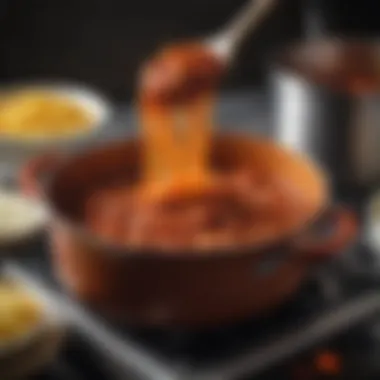
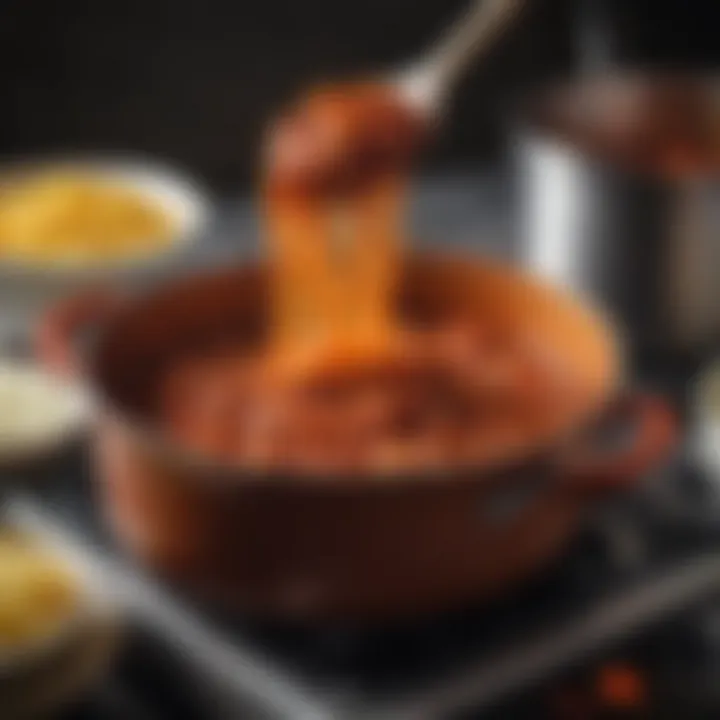
Tomato paste is another essential element in ragu. It adds a concentrated dosage of tomato flavor, enriching the sauce. Incorporating tomato paste during cooking can create a deeper base, enhancing the overarching flavor. However, caution must be exercised; too much paste can overpower the dish, leading to an overly acidic taste. The key lies in balancing it with other ingredients to create a cohesive sauce.
Wine and Seasonings
Choosing the right wine
Wine is often included to add depth and acidity to ragu. A dry red wine, such as Chianti or Barbera, complements the meat and tomatoes, creating a harmonious blend. The choice of wine influences the overall flavor; higher-quality wine typically yields richer results. Conversely, using poor-quality wine can detract from the dish. Hence, choosing the right wine is a fundamental aspect of crafting an authentic ragu.
Essential herbs and spices
Finally, herbs and spices are what tie everything together in ragu. While commonly used spices include black pepper, nutmeg, and salt, herbs play a vital role, as mentioned previously. Each herb brings its essence to the sauce, creating layers of flavor. The careful selection and incorporation of these herbs are paramount, allowing cooks to create a ragu that resonates with tradition and flavors perfectly balanced.
"The key to a great ragu lies in the quality of ingredients used. Quality meat, vegetables, and spices create a harmonious blend that delights the palate."
By focusing on these key ingredients, home cooks can elevate their ragu experience significantly.
Different Types of Ragu
Understanding the various types of ragu is crucial in appreciating this iconic sauce's diversity and richness. Each type carries its own set of characteristics, reflecting regional traditions, available ingredients, and cultural preferences. By exploring these variations, one gains insight into how geography and heritage shape culinary practices. This segment will delve into three significant types of ragu: Ragu alla Bolognese, Ragu Napoletano, and vegetarian and vegan variants.
Ragu alla Bolognese
Ragu alla Bolognese, often simply known as Bolognese sauce, is perhaps the most recognized type internationally. Originating from the city of Bologna, it is a rich meat sauce that emphasizes a balance between meat, vegetables, and tomatoes. Traditionally, the sauce incorporates ground beef, but it may also include pork or veal, blending flavors to create a deep umami profile.
The key to a successful Ragu alla Bolognese lies in the cooking technique. The ingredients should be cooked slowly, allowing them to meld together. For many, the inclusion of white wine is a distinguishing feature, contributing acidity and enhancing the sauce's complexity. Simmering for an extended period is essential. This technique allows the flavors to develop, resulting in a thick, hearty sauce ideal for pairing with tagliatelle or other pasta.
The authenticity of Ragu alla Bolognese is sometimes debated, with variations emerging in household recipes. Each cook may add their own twist, such as milk to soften the sauce or different herbs for additional aroma. It is this blend of tradition and innovation that keeps Bolognese a favorite among many.
Ragu Napoletano
Ragu Napoletano, hailing from Naples, presents a contrasting style to its Bolognese counterpart. This ragu features larger chunks of meat, often beef or pork, simmered in a tomato base. Here, tomatoes are the hero, imparting a distinctly sweet and rich flavor. Unlike the Bolognese, the focus is more on the tomatoes and less on the meat.
Preparation of Ragu Napoletano can be regarded as a labor of love. The sauce is typically cooked for hours, allowing the meat to become tender and the flavors to deepen. The classic combination includes San Marzano tomatoes, which are celebrated for their sweetness and low acidity, creating a perfect base. Commonly served with pasta, such as ziti or spaghetti, it is preferred by many for its rustic charm.
Ample garlic, olive oil, and a handful of parsley may also be added, underscoring its bold yet uncomplicated flavor. The cultural significance of Ragu Napoletano extends to local celebrations and family gatherings, thus reinforcing community bonds through shared culinary experiences.
Vegetarian and Vegan Variants
With the rise of plant-based diets, vegetarian and vegan ragu variants have gained popularity. These adaptations showcase how traditional recipes can be reimagined without compromising on taste. Unlike their meat-based counterparts, these sauces rely heavily on vegetables, legumes, and sometimes plant-based meat alternatives.
Common vegetables include mushrooms, lentils, and bell peppers. Mushrooms provide a robust, meaty texture, while lentils contribute protein and a hearty feel. Critical to these versions is the seasoning. The incorporation of herbs like basil, oregano, and bay leaves enhances the overall flavor.
Vegetarian and vegan ragu can be prepared using the same slow-cooking techniques that define traditional sauces, allowing flavors to fuse and develop. This method is essential for achieving a satisfying complexity and depth.
By contributing to the expansion of ragu recipes, vegetarian and vegan variants cater to a growing audience concerned about sustainability and health while still valuing rich culinary traditions.
Understanding different ragus allows for a broader appreciation of Italian cuisine and its adaptability across various diets and preferences.
Techniques for the Perfect Ragu
Crafting the perfect ragu goes beyond simply mixing ingredients in a pot. The techniques employed during preparation play a crucial role in shaping the flavor, texture, and overall success of the dish. Mastery of these techniques can elevate a basic ragu into an exquisite culinary experience. Key considerations include the proper browning of meat, the art of sautéing soffritto, and the essential simmering methods that truly develop the sauce's character. Each step not only builds depth of flavor but also enhances the ragu's richness, rewarding the time spent in preparation.
Browning the Meat
The Maillard reaction explained
The Maillard reaction is a chemical process that occurs when meat is cooked at high temperatures. This reaction creates a complex series of flavors and aromas, which enhance the overall taste of the ragu. When the meat is browned, it develops a caramelized crust that contributes to the sauce's richness. This is important as the flavors from browned meat form a foundational base for the ragu.
Using this technique allows cooks to create depth in flavor, making it a popular choice in the preparation of ragu, especially when using different types of meat. The deeper the color of the meat, the more robust the flavors that will infuse the sauce, thus improving the final dish.
Tips for optimal browning
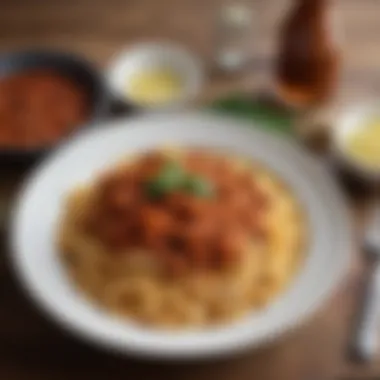
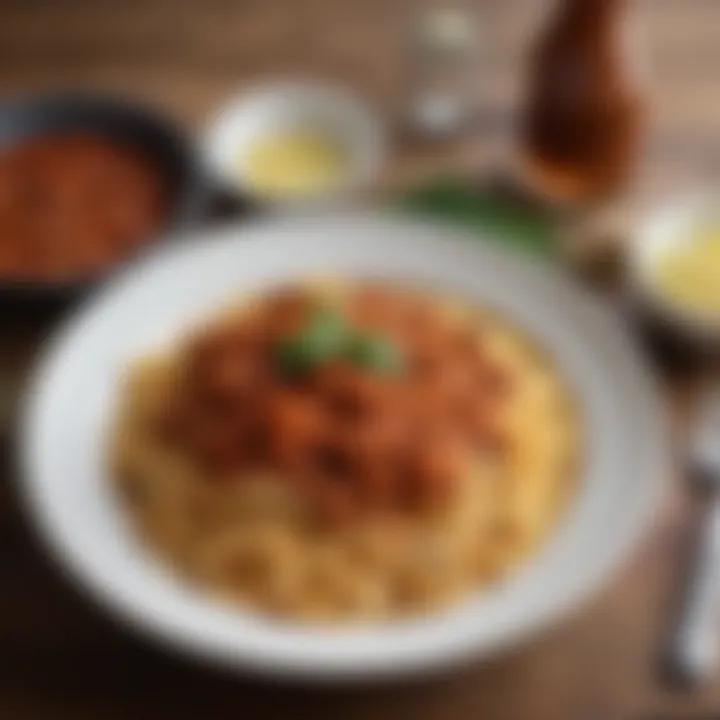
For effective browning, it is essential to consider both the choice of pan and heat level. A heavy skillet, such as cast iron or stainless steel, is preferred as it distributes heat evenly. The meat should not be overcrowded in the pan, as this creates steam rather than allowing for browning. A high heat is needed initially, followed by a reduction once the desired color is achieved. This technique ensures a well-seared exterior that locks in moisture.
The advantage of optimal browning is the enhanced flavor profile it creates. However, care must be taken to avoid burning, which can lead to bitter tastes.
Sautéing the Soffritto
Timing and temperature
The soffritto, typically composed of onions, carrots, and celery, is an essential base for ragu. Proper timing and temperature are critical during this stage. These vegetables should be cooked slowly over lower heat to draw out their natural sugars while allowing them to soften. This slow cooking results in a more aromatic and flavorful base. It's recommended that cooks pay attention to the color of the soffritto. A golden color indicates that the sugars are caramelizing, which is beneficial for flavor development. If cooked too fast, the vegetables can burn, losing their sweetness and leading to an unpleasant taste in the final sauce.
Enhancing flavor development
In addition to timing and temperature, incorporating garlic and herbs during the soffritto seasoning process can further enrich the flavors. Adding these ingredients at the right moment ensures they release their essential oils without burning, which contributes to the overall taste of the ragu. This balance of flavor is why enhancing the soffritto is a popular technique in ragu preparation.
The unique feature of this step lies in its ability to layer flavors. When done correctly, it provides a robust foundation upon which the ragu builds its identity.
Simmering Techniques
Importance of low and slow
Simmering is arguably one of the most crucial techniques in ragu making. Cooking the sauce low and slow allows for the flavors to meld together harmoniously. This method encourages the ingredients to release their natural flavors gradually, resulting in a deeper, more complex sauce. Prolonged simmering helps to tenderize the meat, making it more succulent and enhancing the overall texture of the dish.
With this technique, care must be taken not to let the sauce boil vigorously, which can cause ingredients to break down too rapidly and lose their individual flavors.
Adjusting consistency
During the simmering phase, adjusting the consistency of the ragu is also important. Factors such as the amount of liquid used and the duration of cooking can impact the thickness of the sauce. A well-balanced ragu should have a sauce that clings to the pasta without being overly watery or excessively thick.
This adjustment can be achieved by occasionally checking the sauce during cooking and adding liquid as necessary. The ability to modify the ragu’s consistency to suit personal preference is a unique feature of this technique, offering versatility for various culinary contexts.
Serving Suggestions
Serving suggestions are vital in enhancing the overall ragu experience. A great ragu deserves to be accompanied by the proper elements that elevate its flavors. The right choices can complement the sauce’s richness and depth. This section will explore how to pair ragu effectively with pasta and the best sides to enhance a meal.
Pairing with Pasta
Pairing ragu with pasta goes beyond mere tradition. It is a harmony of textures and flavors that creates a satisfying dish. This pairing affects the overall enjoyment of ragu. The following explores the best pasta shapes and tips for achieving a balanced dish.
Best pasta shapes
When selecting pasta shapes, the best choices are those that trap sauce effectively. Shapes like pappardelle or tagliatelle work well with ragu. These wider noodles catch more sauce due to their surface area. This characteristic allows for a more cohesive bite.
Moreover, sturdy shapes like rigatoni or penne can also be excellent. The ridges in these pastas hold bits of meat and sauce, providing a fulfilling experience. However, delicate types like spaghetti might not hold the ragu as well, leading to a less satisfying meal.
Tips for coating pasta
Coating pasta with ragu requires some attention. Start by undercooking the pasta slightly. This allows better absorption of sauce when mixed. Once drained, it is essential to add the ragu while the pasta is still warm. This warmth helps the sauce meld better with the noodles.
Using a large skillet can also facilitate this process. Combining the pasta and sauce in the skillet allows for better mixing and even coating. This approach enhances flavor distribution. However, over-mixing can lead to a mushy texture, so it is important to be delicate.
Accompaniments and Sides
Choosing the right accompaniments can significantly enhance a ragu meal. Breads and cheeses, as well as salads and vegetables, play important roles in bringing balance and contrast to the dish. They can elevate the meal in various ways and should be chosen carefully.
Breads and cheeses
Breads are essential for complementing ragu. A crusty Italian bread like ciabatta or focaccia works well. These types are perfect for soaking up the remaining sauce. Their texture provides a satisfying contrast to the pasta.
Cheeses like Parmigiano-Reggiano add a sharp, nutty flavor that pairs wonderfully with the richness of ragu. They can be shaved or grated over the dish right before serving. This practice adds an extra layer of flavor that enhances the overall experience.
Salads and vegetables
Incorporating salads or vegetables brings freshness to a ragu meal. A simple green salad with a light vinaigrette balances the heavy ragu. It introduces crispness and acidity, which can help cut through the richness of the sauce.
Steamed or roasted vegetables can also work well as sides. Choices like zucchini or asparagus provide color and additional nutrients to the meal. However, it's important to avoid heavy or rich vegetable preparations that might overshadow the ragu itself.
Ragu Preservation Techniques
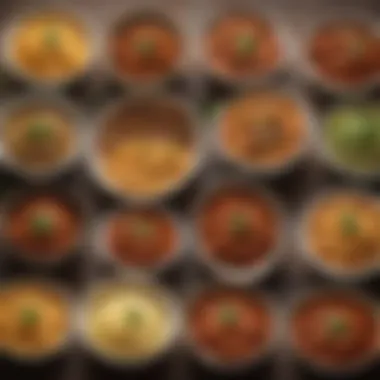

The ability to preserve ragu is essential for lovers of this rich sauce. Effective preservation allows the enjoyment of homemade ragu beyond a single meal. Not all methods are equal, and this section will explore various strategies for storing and reheating ragu. The goal is to maintain its quality, texture, and flavor.
Storage Methods
Managing how ragu is stored is important because it impacts its taste and safety. Two common methods are refrigeration and freezing. Each has distinct features and benefits.
Refrigeration vs. freezing
Refrigeration is a widely used method. It keeps ragu fresh for up to a week. This short-term solution is ideal for quick meals. On the other hand, freezing ragu can extend its shelf life to several months. Freezing preserves the sauce effectively, but it can affect the texture.
A critical characteristic of refrigeration is convenience. It allows quick access without the need for defrosting. However, frozen ragu might taste slightly different upon reheating. The main advantage of freezing is its long-lasting nature. Choosing between these methods depends on how soon you plan to use the sauce.
Best containers for storage
Choosing the right container is also vital for storing ragu. Glass containers are popular because they are non-reactive. They keep ragu fresh and can go from refrigerator to microwave. Plastic containers are lightweight and durable; however, some may absorb odors from the sauce.
An essential feature of these containers is an airtight seal. This helps to prevent any spoilage from outside air. The unique advantage of using BPA-free plastic is its resilience in the freezer. Depending on your priorities, glass or plastic can work well.
Reheating Strategies
Reheating ragu correctly is crucial to staying true to its original flavor. If done improperly, it could lead to a less satisfying texture and taste. This section will discuss how to maintain the qualities of ragu.
Maintaining texture and flavor
When reheating ragu, the goal is to regain its original richness. Consistent temperature is important to prevent overcooking. This ensures that the meat and sauce maintain their intended textures. An appropriate method keeps the flavors intact, creating an authentic experience.
Utilizing low heat can gradually warm the sauce, preventing it from burning or drying out. The best approach is to add a splash of water or broth if the ragu feels too thick. This can be a good technique when done with care.
Microwave vs. stovetop
Deciding whether to use a microwave or stovetop adds to the reheating debate. Microwaves are fast and convenient. However, they might result in uneven heating. This can lead to parts of the ragu losing moisture, which change the flavor.
In contrast, reheating on the stovetop can guarantee more control. It may take longer but keeps the sauce at the ideal temperature. This allows for even heat distribution. Ultimately, choosing depends on your time and preference.
To preserve the authentic taste of ragu, proper storage and reheating techniques are essential. Both processes ensure your sauce remains delightful even after days in the fridge or freezer.
Ending: Elevating Your Ragu Experience
Crafting the perfect ragu is not just a culinary task; it’s an art that demands attention to detail and appreciation for the nuances of flavor and texture. This article has illuminated the journey of ragu making from its rich definitions and cultural significance to the methods and ingredients that transform simple elements into a remarkable sauce. Each section provided insights on the importance of selecting quality meats, the role of fresh vegetables, and the right balance of seasonings. Moreover, understanding preservation techniques ensures that your ragu remains delicious and convenient for future meals.
Highlighting the essence of this culinary exploration is key. It connects readers to the tradition of Italian cooking, emphasizing that ragu is more than a mere sauce; it is a vessel of history and creativity. The ability to adapt techniques and ingredients opens doors to endless possibilities, making ragu accessible to everyone, regardless of cookong experience. The benefits of mastering ragu are numerous: enhanced flavors in meals, the joy of sharing food with others, and the satisfaction of creating something from scratch.
"Ragu is not a recipe; it's a love letter to the ingredients and traditions that shaped Italian cuisine."
Through careful exploration of various types of ragu, including Ragu alla Bolognese and Ragu Napoletano, the rich regional differences within Italy become evident. This understanding invites enthusiasts to experiment with authenticity while encouraging innovation in their own kitchens. In summary, the techniques and variations discussed not only enrich your culinary skills but also deepen your appreciation for this iconic dish, making every plate of ragu a personal expression of culture and taste.
Recap of Key Points
- Understanding the Fundamental Ingredients:
- Mastering Cooking Techniques:
- Serving and Preserving Ragu:
- Cultural Context:
- Personal Versatility:
- The choice of meat and quality directly influences the depth of flavor.
- Vegetables like onions, carrots, and celery serve as essential aromatics.
- A proper tomato base is crucial, whether using fresh or canned tomatoes.
- Browning the meat initiates the Maillard reaction, enhancing flavor through caramelization.
- The soffritto should be carefully sautéed, allowing flavors to develop fully before adding other ingredients.
- Pairing ragu with the right pasta enhances the overall dining experience.
- Proper storage and reheating techniques maintain the ragu's texture and flavor for future meals.
- Ragu embodies a rich culinary tradition that varies from region to region in Italy.
- As a cook becomes more familiar with ragu, innovation and personal twists become natural.
Final Thoughts on Crafting Ragu
Crafting ragu is a journey worth undertaking. The art lies in balance, from the selection of premium ingredients to the methodical cooking techniques. Remember, each cook has their own unique touch, informed by personal taste and experience.
As you develop your ragu skills, don't hesitate to experiment and make the recipe your own. Whether you lean towards traditional approaches or choose a modern twist, the key is to savor the process. The time spent creating a ragu will yield rewards, filling not just the stomach but also the heart with the warmth of homemade cooking. Elevating your ragu is about finding joy in the kitchen and bringing loved ones together over a comforting plate of this iconic sauce.















